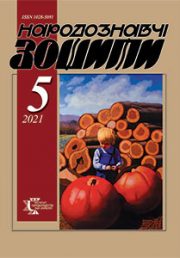The Ethnology Notebooks. 2022. № 2 (164), 349—364
UDK [398.21(=161.2):316.64(=1:477.82-2)”193/194″]: 930.2
DOI https://doi.org/10.15407/nz2022.02.349
BETWEEN POLES, GERMANS AND «SOVIETS»: FOLK NARRATIVES ABOUT ANTI-UKRAINIAN ACTIONS NEAR LUTSK
CHIKALO Oksana
- ORCID ID: https://orcid.org/0000-0002-1636-3397
- Candidate of Philological Sciences,
- Senior Researcher,
- Institute of Ethnology
- of the National Academy of Sciences of Ukraine,
- department of folklore,
- 15, Svobody Avenue, 79000, Lviv, Ukraine,
- Contacts: e-mail: chikalooksana@gmail.com
Abstract. Subject of study The article analyzes folk tales that reflect the folk vision of historical events and modern social life in Volhynia in the late 1930s — early 1940s. Narratives are considered through the prism of personal experience of narrators — participants and witnesses of the tragic events of this period.
The purpose of the publication is to analyze oral stories about anti-Ukrainian punitive actions around Lutsk, which took place in the first half of 1943 in Volyn, to consider basic concepts, and thus the plot-motive fund, illustrating the popular interpretation of socio-political processes and life during World War II.
The object of the research are folk narratives recorded during field surveys of the area around Lutsk (2019). These are folk tales about punitive actions against Ukrainians carried out by German units, Polish police or settlers from the so-called «sites», as well as works about national liberation struggles in Volhynia in the first third and middle of the twentieth century, which are still carried by participants and witnesses to that struggle, as well as their descendants.
The article synthesizes the methods subordinated to the purpose of exploration: structural-semiotic and structural-typological, which allow to analyze folk narratives as a set of constituent parts and their semantics. The interdisciplinary method made it possible to attract materials from other scientific disciplines: history, ethnology, ethnopsychology, statistics. The use of the achievements of these industries allows us to reveal the peculiarities of the reproduction of historical events through the prism of the folk epic. An indispensable method is field research, which made it possible to record narratives about the events of the Second World War in Volhynia and made it possible to find out the peculiarities of the existence and distribution of folk tales on this topic.
Keywords: narrative, folk tale, concept, theme, motive, semantics, narrator, ethnostereotype.
Received 5.05.2022
REFERENCES
- Kalischuk, O. (2020). Volyn’43: historiographical knowledge and a crooked mirror of memory. Lviv [in Ukrainian].
- Kalischuk, O. (2013). Ukrainian-Polish confrontation in Volhynia and Galicia during the Second World War: scientific and social discourses (Dr. hist. sci. diss. abstr.) [in Ukrainian].
- (2011). Polish-Ukrainian relations in 1942—1947 in the documents of the OUN and UPA. Lviv [in Ukrainian].
- Kachmar, M. (2020). The tragedy of the Red Garden in the folk prose of Ukrainians. Bulletin of Zaporizhia National University. Philological sciences, 1 (II), 204—220 [in Ukrainian].
- Demedyuk, M. (2019). Interethnic interaction in the folklore prose of Volyn Polissya about the events of 40—60 years of the twentieth century. The Ethnology notebooks, 4 (148), 898—905 [in Ukrainian].
- Chikalo, O. (2020). Folk prose on Ukrainian-Polish relations on the eve of World War II (based on materials from the Gorokhiv district of Volyn region). The Ethnology notebooks, 3 (153), 558—562 [in Ukrainian].
- Britsyna, O. (2010). Twentieth century in the oral history of Ukrainians (notes on the historicism of folklore). In search of one’s own voice: oral history as a theory, method and source. Kharkiv [in Ukrainian].
- Pushchuk, I. (2018). Volynians about «Volyn-43»: Ukrainian memory of the Polish expansion to the Ukrainian northwest in 1938—1944: oral historical evidence: Volyn region, Rivne region, Southern Volyn (Kremenets region), Brest region, Podlasie, Kholmshchina). Lutsk [in Ukrainian].
- Grinchenko, G. (Ed.). (2004). Oral history — theory, method, source. Unimaginative. Oral stories of ostarbeiters. Kharkiv: Ryder Publishing House [in Ukrainian].
- Myshanych, S. (2003). Near the sources of folk prose. Folklore and literary works (Vol. 1). Donetsk [in Ukrainian].
- Kuzmenko, O. (2018). Dramatic life in Ukrainian folklore: conceptual forms of expression (the period of the First and Second World Wars). Lviv [in Ukrainian].
- Hud, B. Volyn tragedy: hatred of Ukrainians for Poles was formed for decades. Prerequisites and motives. Retrieved from: https://www.radiosvoboda.org/a/volynska-trahediya-polyaky-ukrayintsi-dyversanty-bandy/31352114.html [in Ukrainian].
- Koval, M. (1997). Volksdeutsch. Small Dictionary of the History of Ukraine. Кyiv: Lybid [in Ukrainian].
- Oliynyk, Y., & Zavalnyuk, O. (2012). Nazi occupation regime in the general district «Volyn-Podillya» (1941—1944). Khmelnytsky [in Ukrainian].
- Isaevich, J.(2003). Kholm-Volyn tragedy, its preconditions, course, consequences. Volyn and Kholmshchyna 1938—1947: Polish-Ukrainian confrontation and its echoes. Research, documents, memoirs. Lviv [in Ukrainian].
- Ukrainian Insurgent Army. Retrieved from: https://uinp.gov.ua/informaciyni-materialy/viyskovym/ukrayinska-povstanska-armiya [in Ukrainian].
- Uhach, V. (2017). «Difficult» issues of Ukrainian-Polish relations in 1942— 1944: visions of modern Ukrainian historians. Archives of Ukraine, 5—6, 189—198 [in Ukrainian].
- Bihun, I. «Genocide» instead of a history lesson. Facts that do not fit into the Polish version of the Volyn tragedy. Retrieved from: https://www.istpravda.com.ua/columns/2016/11/ 19/149334/ [in Ukrainian].
- Denisyuk, I. (2003). National specifics of Ukrainian folklore. Word and time, 9, 16—24 [in Ukrainian].
- Karban, A. (2015). Images in oral folk tales about the Holodomor of 1932—1933: transmission of tradition. Literary studies (Issue 1 (1). Kyiv [in Ukrainian].
- Bodak, V. Christian moral imperative: cultural opportunities. Retrieved from: http: //dspace.nbuv.gov.ua/bitstream/handle/123456789/20443/03_Bodak.pdf? Sequence = 1 [in Ukrainian].
- Semenets, O. Places of memory. Retrieved from: http://mcmc.tilda.ws/memory [in Ukrainian].
- Deportations. Western lands of Ukraine in the late 30’s — early 50’s. Documents, materials, memoirs (1996—2003) (Vol. 1, pp. 32—44). Lviv [in Ukrainian].
- Pasternak, E. (1968). Essay on the history of Kholm and Podlasie. Winnipeg.
- Hrushevsky, M. (1994). History of Ukrainian literature (Vol. 4, book 2). Kyiv: Lybid [in Ukrainian].
- Efremov, S. (1997). Diaries, 1923—1929. Kyiv [in Ukrainian].
- Dyakiv, V. (2008). Folklore of miracles in sub-Soviet Ukraine in the 1920s. Lviv [in Ukrainian].




